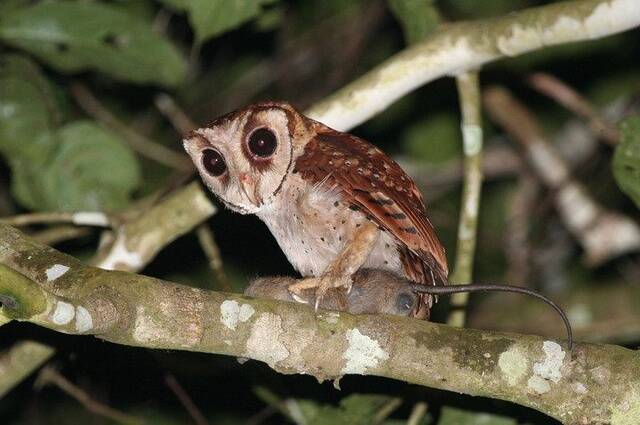Phodilus badius
IUCN
LCBasic Information
Scientific classification
- name:Phodilus badius
- Scientific Name:Phodilus badius,Oriental Bay-owl
- Outline:Raptor
- Family:Strigiformes Owlidae Owl
Vital signs
- length:About 29 cm
- Weight:311-360g
- lifetime:About 10-15 years
Feature
A medium-sized rufous owl.
Distribution and Habitat
Origin: Bangladesh, Brunei Darussalam, Cambodia, China, India, Indonesia, Lao People's Democratic Republic, Malaysia, Myanmar, Thailand and Vietnam.
Possibly extinct: Philippines. Regionally extinct: Singapore. Wandering: Nepal.
The Chestnut Owl is a resident bird that inhabits dense evergreen broadleaf, coniferous and secondary forests in mountainous areas. [3] Especially in foothills below 1,800 m, submontane forests and montane forests in mainland Southeast Asia. In Java, the preferred habitat is foothills at 200–1,000 m and submontane forests at 1,000–1,500 m, but deforestation has forced the owl to migrate from the mountainous and central regions to the montane forests. The highest altitude recorded is 2,300 m. It also lives in densely leafed forests between farmland and rice fields in fruit trees near cultivated land and cultivated land.
Appearance
Chestnut Owl, forehead, facial plate, chin and throat are light grape red, and the front of the eyes and inner eye rims are dark chestnut. There is a white streak from the side of the neck to the chest, mixed with brown and chestnut feathers, and the back of the head and nape of the neck are dark chestnut. The upper back, shoulders and inner wing coverts are brownish-yellow with maroon feather edges and proximal black spots; the lower back is light maroon with black spots. Both wings are mostly brown maroon with black horizontal spots. The outer part of the first primary flight feather and the small covert feathers are all edged with white. The proximal end of the second primary flight feather is decorated with 3 white spots. The tail is light maroon and also has Multiple black horizontal spots. The underparts and coverts are grape red. Also decorated with black spots. The upper chest is orange-yellow, and the feathers in the middle of the lower abdomen and around the anus are lighter
Details
Oriental Bay-owl, also known as Oriental Bay-owl, has a heart-shaped face and erect ears that are very similar to those of a barn owl. There are four subspecies.

Chestnut owls often move alone or in pairs, and sometimes in small groups of 2-3. It is a nocturnal bird, roosting during the day on tree trunks or tree holes, or on branches shaded by palm leaves, or in the bends of thick horizontal vines, usually no more than 2 meters from the forest floor. It sits flat during the day, like the Black-capped Frogmouth, and is not alert when roosting, making it easy to approach. It is nocturnal and is active mainly at night, dusk and before dawn.
The sound of the Chestnut Owl is like a typical song, a series of 4-7 syllables or louder, melancholy whistles, about 2 notes per second, which can last for 2-8 seconds. It starts loud, and the following notes rise slightly. These short calls are often repeated many times, sometimes gradually in descending pitch. When the Chestnut Owl moves from one place to another, these whistles are sometimes alternated with a series of different and shorter whistles, kleet-kleet-kleet or kleek-kleek-kleek. It tends to start singing in the evening. Can be quite noisy during the breeding season, especially after midnight.
Chestnut Owls feed mainly on animal food such as small rodents (such as mice and rats), bats, birds, lizards, frogs and large insects (such as beetles and grasshoppers). They hunt in their habitat, flying through young trees under the dense forest canopy to make the kill. This is all achieved with their relatively short and rounded wings. Generally tend to hunt near water sources.
The breeding season of Chestnut Owls varies depending on the distribution area. The breeding season in Nepal and Sikkim is from March to May, and in Java it is from March to July. Nests are located in tree holes, rotten trunks or stumps and caves. There are also reports of nesting in palm leaf layers on the island of Java. There are also reports of using artificial nest boxes. Each nest contains 3-5 eggs, which are white, smooth and spotless. The eggs are oval in shape, 33-37 mm × 28-31 mm in size, and are laid about 2 days apart. Incubation begins with the first egg, which is incubated by the female alone, while the male brings food to the female. The incubation and maturity period are unknown.
Listed in Appendix II of the Washington Convention on International Trade in Endangered Species (CITES).
Listed in the IUCN Red List of Threatened Species in 2018 ver 3.1 - Least Concern (LC).
Listed in the second level of the China National Key Protected Wildlife List.
Protect wild animals and stop eating game.
Maintaining ecological balance is everyone's responsibility!








